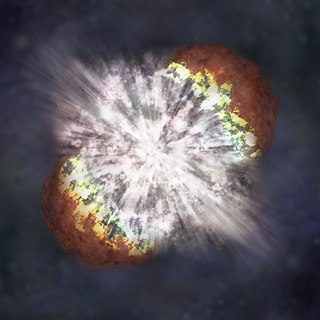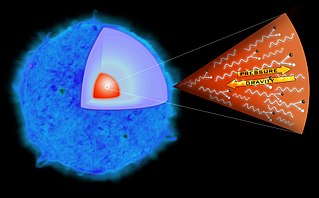Related Research Articles

A supernova is a powerful and luminous stellar explosion. This transient astronomical event occurs during the last evolutionary stages of a massive star or when a white dwarf is triggered into runaway nuclear fusion. The original object, called the progenitor, either collapses to a neutron star or black hole, or is completely destroyed. The peak optical luminosity of a supernova can be comparable to that of an entire galaxy before fading over several weeks or months.

Stellar evolution is the process by which a star changes over the course of time. Depending on the mass of the star, its lifetime can range from a few million years for the most massive to trillions of years for the least massive, which is considerably longer than the age of the universe. The table shows the lifetimes of stars as a function of their masses. All stars are formed from collapsing clouds of gas and dust, often called nebulae or molecular clouds. Over the course of millions of years, these protostars settle down into a state of equilibrium, becoming what is known as a main-sequence star.

SN 1987A was a type II supernova in the Large Magellanic Cloud, a dwarf satellite galaxy of the Milky Way. It occurred approximately 51.4 kiloparsecs from Earth and was the closest observed supernova since Kepler's Supernova. 1987A's light reached Earth on February 23, 1987, and as the earliest supernova discovered that year, was labeled "1987A". Its brightness peaked in May, with an apparent magnitude of about 3.

Supergiants are among the most massive and most luminous stars. Supergiant stars occupy the top region of the Hertzsprung–Russell diagram with absolute visual magnitudes between about −3 and −8. The temperature range of supergiant stars spans from about 3,400 K to over 20,000 K.

Red supergiants (RSGs) are stars with a supergiant luminosity class of spectral type K or M. They are the largest stars in the universe in terms of volume, although they are not the most massive or luminous. Betelgeuse and Antares are the brightest and best known red supergiants (RSGs), indeed the only first magnitude red supergiant stars.

A super-luminous supernova is a type of stellar explosion with a luminosity 10 or more times higher than that of standard supernovae. Like supernovae, SLSNe seem to be produced by several mechanisms, which is readily revealed by their light-curves and spectra. There are multiple models for what conditions may produce an SLSN, including core collapse in particularly massive stars, millisecond magnetars, interaction with circumstellar material, or pair-instability supernovae.

Wolf–Rayet stars, often abbreviated as WR stars, are a rare heterogeneous set of stars with unusual spectra showing prominent broad emission lines of ionised helium and highly ionised nitrogen or carbon. The spectra indicate very high surface enhancement of heavy elements, depletion of hydrogen, and strong stellar winds. The surface temperatures of known Wolf–Rayet stars range from 20,000 K to around 210,000 K, hotter than almost all other kinds of stars. They were previously called W-type stars referring to their spectral classification.

A stellar black hole is a black hole formed by the gravitational collapse of a star. They have masses ranging from about 5 to several tens of solar masses. The process is observed as a hypernova explosion or as a gamma ray burst. These black holes are also referred to as collapsars.

NGC 6946, sometimes referred to as the Fireworks Galaxy, is a face-on intermediate spiral galaxy with a small bright nucleus, whose location in the sky straddles the boundary between the northern constellations of Cepheus and Cygnus. Its distance from Earth is about 25.2 million light-years or 7.72 megaparsecs, similar to the distance of M101 in the constellation Ursa Major. Both were once considered to be part of the Local Group, but are now known to be among the dozen bright spiral galaxies near the Milky Way but beyond the confines of the Local Group. NGC 6946 lies within the Virgo Supercluster.

Luminous blue variables (LBVs) are massive evolved stars that show unpredictable and sometimes dramatic variations in both their spectra and their brightness. They are also known as S Doradus variables after S Doradus, one of the brightest stars of the Large Magellanic Cloud. They are extraordinarily rare, with just 20 objects listed in the General Catalogue of Variable Stars as SDor, and a number of these are no longer considered to be LBVs.

NGC 7793 is a flocculent spiral galaxy in the southern constellation of Sculptor. It was discovered in 1826 by Scottish astronomer James Dunlop. The galaxy is located at a distance of 12.2 million light years and is receding with a heliocentric radial velocity of 227 km/s. NGC 7793 is one of the five brightest galaxies within the Sculptor Group.

Type Ib and Type Ic supernovae are categories of supernovae that are caused by the stellar core collapse of massive stars. These stars have shed or been stripped of their outer envelope of hydrogen, and, when compared to the spectrum of Type Ia supernovae, they lack the absorption line of silicon. Compared to Type Ib, Type Ic supernovae are hypothesized to have lost more of their initial envelope, including most of their helium. The two types are usually referred to as stripped core-collapse supernovae.

A Type II supernova results from the rapid collapse and violent explosion of a massive star. A star must have at least 8 times, but no more than 40 to 50 times, the mass of the Sun (M☉) to undergo this type of explosion. Type II supernovae are distinguished from other types of supernovae by the presence of hydrogen in their spectra. They are usually observed in the spiral arms of galaxies and in H II regions, but not in elliptical galaxies; those are generally composed of older, low-mass stars, with few of the young, very massive stars necessary to cause a supernova.

A pair-instability supernova is a type of supernova predicted to occur when pair production, the production of free electrons and positrons in the collision between atomic nuclei and energetic gamma rays, temporarily reduces the internal radiation pressure supporting a supermassive star's core against gravitational collapse. This pressure drop leads to a partial collapse, which in turn causes greatly accelerated burning in a runaway thermonuclear explosion, resulting in the star being blown completely apart without leaving a stellar remnant behind.

Gamma-ray burst progenitors are the types of celestial objects that can emit gamma-ray bursts (GRBs). GRBs show an extraordinary degree of diversity. They can last anywhere from a fraction of a second to many minutes. Bursts could have a single profile or oscillate wildly up and down in intensity, and their spectra are highly variable unlike other objects in space. The near complete lack of observational constraint led to a profusion of theories, including evaporating black holes, magnetic flares on white dwarfs, accretion of matter onto neutron stars, antimatter accretion, supernovae, hypernovae, and rapid extraction of rotational energy from supermassive black holes, among others.

N6946-BH1 is a disappearing giant star in another galaxy, NGC 6946, on the northern border of the constellation of Cygnus. The star, either a red supergiant or a yellow hypergiant, was 25 times the mass of the sun, and was 20 million light years distant from Earth. In March through to May 2009 its bolometric luminosity increased to at least a million solar luminosities, but by 2015 it had disappeared from optical view. In the mid and near infrared an object is still visible, however, it is fading away with a brightness proportional to t−4/3. The brightening was insufficient to be a supernova, and is called a failed supernova.

A hypernova is a very energetic supernova thought to result from an extreme core-collapse scenario. In this case, a massive star collapses to form a rotating black hole emitting twin energetic jets and surrounded by an accretion disk. It is a type of stellar explosion that ejects material with an unusually high kinetic energy, an order of magnitude higher than most supernovae, with a luminosity at least 10 times greater. They usually appear similar to a type Ic supernova, but with unusually broad spectral lines indicating an extremely high expansion velocity. Hypernovae are one of the mechanisms for producing long gamma ray bursts (GRBs), which range from 2 seconds to over a minute in duration. They have also been referred to as superluminous supernovae, though that classification also includes other types of extremely luminous stellar explosions that have different origins.

iPTF14hls is an unusual supernova star that erupted continuously for about 1,000 days beginning in September 2014 before becoming a remnant nebula. It had previously erupted in 1954. None of the theories nor proposed hypotheses fully explain all the aspects of the object.
SN 2009ip was a supernova discovered in 2009 in the spiral galaxy NGC 7259 in the constellation of Piscis Austrinus. Since the brightness waned after days post-discovery, it was redesignated as Luminous blue variable (LBV) Supernova impostor.
Ken’ichi Nomoto is a Japanese astrophysicist and astronomer, known for his research on stellar evolution, supernovae, and the origin of heavy elements.
References
- ↑ Woosley, S. E.; Heger, Alexander (2012). "Long Gamma-Ray Transients from Collapsars". The Astrophysical Journal. 752 (1): 32. arXiv: 1110.3842 . Bibcode:2012ApJ...752...32W. doi:10.1088/0004-637X/752/1/32. S2CID 119240065.
- 1 2 3 Lee Billings (November 2015). "Gone Without A Bang". Scientific American. 313 (5): 26–27. Bibcode:2015SciAm.313e..26B. doi:10.1038/scientificamerican1115-26b. PMID 26638393.
- ↑ Jon Voisey (2 April 2011). "Finding the Failed Supernovae". Universe Today.
- 1 2 Eugene Myers (27 September 2016). "This star was so massive it ate itself before it could go supernova". Astronomy Magazine.
- ↑ Reynolds, Thomas M.; Fraser, Morgan; Gilmore, Gerard (21 July 2015). "Gone without a bang: An archival HST survey for disappearing massive stars". Monthly Notices of the Royal Astronomical Society (published November 2015). 453 (3): 2885–2900. arXiv: 1507.05823 . Bibcode:2015MNRAS.453.2885R. doi:10.1093/mnras/stv1809. S2CID 119116538.
- ↑ Gerke, J. R.; Kochanek, C. S.; Stanek, K. Z. (6 November 2014). "The Search for Failed Supernovae with The Large Binocular Telescope: First Candidates". Monthly Notices of the Royal Astronomical Society (published July 2015). 450 (3): 3289–3305. arXiv: 1411.1761 . Bibcode:2015MNRAS.450.3289G. doi:10.1093/mnras/stv776. S2CID 119212331.

